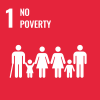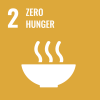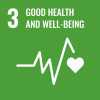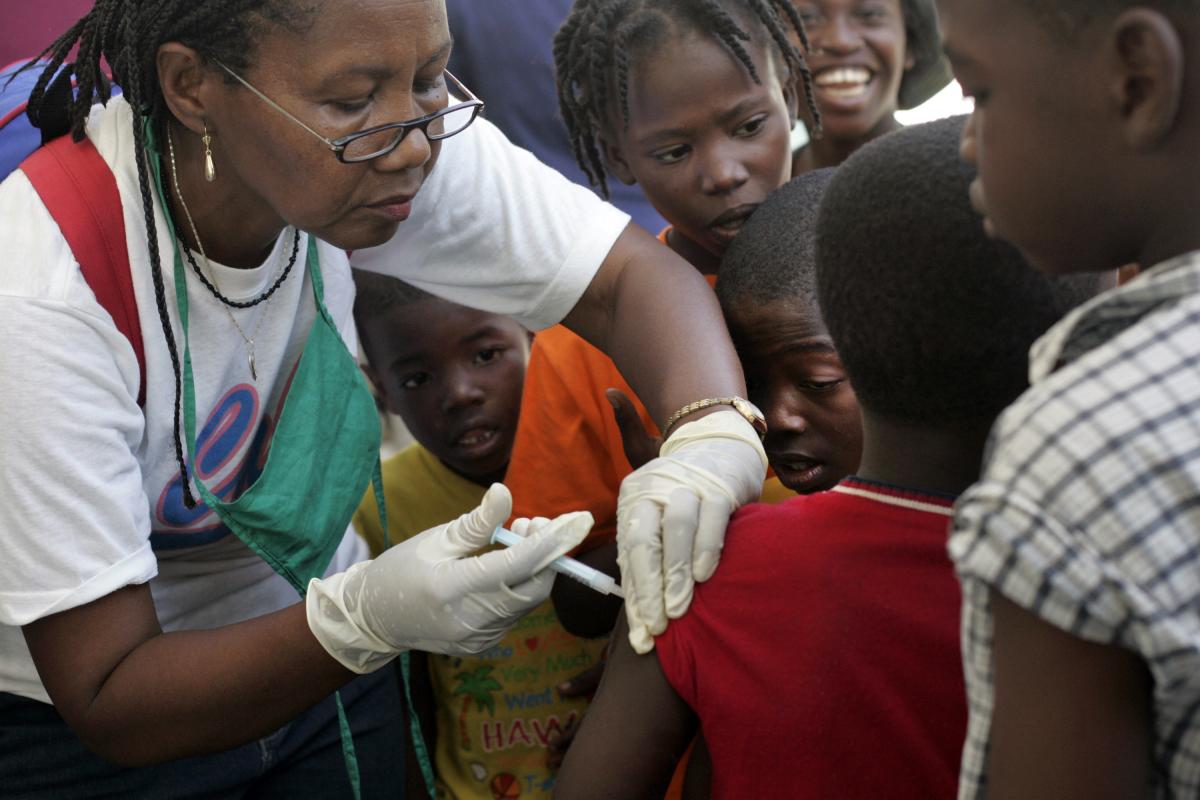
 COVID-19 has been a tragedy, killing more than 775,000 people globally and directly impacting life and health, with over 21 million confirmed cases. The various containment measures are affecting hundreds of millions of people and their livelihoods. The aggregate effect at the national and global levels will persist for a long time. COVID-19, and the measures to control it, has significantly slowed economic growth, increased unemployment, worsened inequality, and raised poverty and hunger in many countries around the world. The World Economic Situation and Prospects as of mid-2020 projected that the global economy will shrink by 3.2 per cent in 2020. The projected cumulative output losses during 2020 and 2021—nearly $8.5 trillion—will wipe out nearly all output gains of the previous four years. Meanwhile, the World Bank estimated global output to shrink by 5.2 per cent in 2020 (World Bank, 2020a). The divergence of global growth estimates, to a great extent, reflects the significant uncertainties around the magnitude of COVID-19’s impact. Moreover, the dismal economic growth could lead to an additional 25 million people unemployed worldwide (ILO, 2020). The global poverty headcount is estimated to increase by as much as 100 million people this year, assuming the income distribution does not change (World Bank, 2020b). Hunger will also increase, with the number of people facing acute food insecurity expected to rise significantly. These deprivations are likely to hit harder among children, women, and older persons, as well as the least developed countries (LDCs), small island developing States (SIDS), and other vulnerable developing countries. While the COVID-19 crisis has been damaging for many of the people– and prosperity-related SDGs, many planet-related goals have seen some temporary improvements during the pandemic. For example, annual CO2 emissions for 2020 are projected to be 4–7 per cent lower than last year. Air and water became cleaner; and in many places, a resurgence of nature was observed. The above divergent outcomes reveal, once more, that the current ways of achieving prosperity are a threat to the health of the planet. The zoonotic nature of COVID-19 and other recent epidemics—such as SARS, MERS, Ebola, and the bird flu—show the importance of protecting the planet and sharing it in a balanced way with other animal and plant species. The impact of COVID-19 deepens further the concern over whether the SDGs can be achieved by 2030. The answer depends to a large extent on how human societies themselves respond to the COVID-19 crisis and its aftermath. To illustrate, this year’s Sustainable Development Outlook presents three scenarios of SDG achievement, namely the pre-COVID-19 benchmark scenario and the post-COVID-19 pessimistic and optimistic scenarios.
COVID-19 has been a tragedy, killing more than 775,000 people globally and directly impacting life and health, with over 21 million confirmed cases. The various containment measures are affecting hundreds of millions of people and their livelihoods. The aggregate effect at the national and global levels will persist for a long time. COVID-19, and the measures to control it, has significantly slowed economic growth, increased unemployment, worsened inequality, and raised poverty and hunger in many countries around the world. The World Economic Situation and Prospects as of mid-2020 projected that the global economy will shrink by 3.2 per cent in 2020. The projected cumulative output losses during 2020 and 2021—nearly $8.5 trillion—will wipe out nearly all output gains of the previous four years. Meanwhile, the World Bank estimated global output to shrink by 5.2 per cent in 2020 (World Bank, 2020a). The divergence of global growth estimates, to a great extent, reflects the significant uncertainties around the magnitude of COVID-19’s impact. Moreover, the dismal economic growth could lead to an additional 25 million people unemployed worldwide (ILO, 2020). The global poverty headcount is estimated to increase by as much as 100 million people this year, assuming the income distribution does not change (World Bank, 2020b). Hunger will also increase, with the number of people facing acute food insecurity expected to rise significantly. These deprivations are likely to hit harder among children, women, and older persons, as well as the least developed countries (LDCs), small island developing States (SIDS), and other vulnerable developing countries. While the COVID-19 crisis has been damaging for many of the people– and prosperity-related SDGs, many planet-related goals have seen some temporary improvements during the pandemic. For example, annual CO2 emissions for 2020 are projected to be 4–7 per cent lower than last year. Air and water became cleaner; and in many places, a resurgence of nature was observed. The above divergent outcomes reveal, once more, that the current ways of achieving prosperity are a threat to the health of the planet. The zoonotic nature of COVID-19 and other recent epidemics—such as SARS, MERS, Ebola, and the bird flu—show the importance of protecting the planet and sharing it in a balanced way with other animal and plant species. The impact of COVID-19 deepens further the concern over whether the SDGs can be achieved by 2030. The answer depends to a large extent on how human societies themselves respond to the COVID-19 crisis and its aftermath. To illustrate, this year’s Sustainable Development Outlook presents three scenarios of SDG achievement, namely the pre-COVID-19 benchmark scenario and the post-COVID-19 pessimistic and optimistic scenarios.
Baseline and alternative scenarios of SDG achievement
The pre-COVID-19 benchmark scenario was laid out in the 2019 Global Sustainable Development Report (GSDR) (Independent Group of Scientists appointed by the United Nations Secretary-General, 2019). It classified SDG targets into three groups: (i) targets that are on track; (ii) targets within reach with extra efforts; and (iii) targets in regression. While many of the people– and prosperity-related SDGs belong to the second group, with a few being in the first, all the planet-related SDGs fall into the third. Analyses of COVID-19 experiences show that many countries took various emergency measures to strengthen their healthcare, social protection, and in some cases, overall governance systems to deal with the crisis. The post-COVID-19 scenario of a country therefore depends on whether it sustains these emergency positive changes and builds on them, rather than reverting to the pre-COVID-19 state. Overall, the kind of post-COVID-19 scenario that takes hold of a country depends on whether it can: (i) minimize the damage caused by COVID-19; (ii) recover quickly from the damages; (iii) hold on and build further on the positive changes introduced to its healthcare, social protection, and governance systems during the pandemic; (iv) sustain and bolster positive gains made regarding the planet-related SDGs, while countering negative environmental effects such as plastic pollution and illegal deforestation; and (v) reenergize its general effort toward sustainable development. Should countries succeed at the above efforts, they can be expected to enter the optimistic scenario. Otherwise, the pessimistic scenario is likely to prevail, driving these countries further away from attaining sustainable development.
Success with the SDGs is tied to success dealing with COVID-19
The COVID-19 experience shows that countries that had made more progress in achieving the SDGs were able to better deal with the COVID-19 crisis. For example, countries that had achieved access to clean water (SDG 6); reduced number of people living in slums (SDG 11); and decreased pre-existing adverse health conditions such as non-communicable diseases (SDG 3) had more success in mitigating the COVID-19 risk. Similarly, past progress in smartphone and internet penetration (SDG 9) helped ensure accessible communication between the public and the government, helping containment measures to be more successful. Of all the determinants of COVID-19 performance, the most important proved to be the healthcare system (SDG 3), social protection system (SDG 1 and 8), and the overall governance system (SDG 16). Unique country-specific factors did play an important role in the COVID-19 performance. However, their role was generally mediated through their impact on the healthcare, social protection, and overall governance systems.
Building on the economic responses to COVID-19
Countries across the world have taken up recovery measures, amounting to over 10 per cent of world gross product; but the efforts have been uneven. Proper spending of these resources not only can facilitate recovery but also help “Build Back Better,” ensuring that post-COVID-19 economic growth and employment expansion are more oriented toward sustainable development. To support employment and income, many governments have rapidly employed monetary policies aimed at inserting liquidity into the financial system. However, in the absence of complementary measures, much of this additional liquidity may end up in precautionary balances and not have the desired effects. Fiscal measures that boost immediate consumption spending are therefore necessary and more effective. Moreover, fiscal policy should, to the extent possible, target vulnerable population groups, including women, youth, elderly, and migrants, that are disproportionately affected by the pandemic, thereby helping to address inequality. Facing limited fiscal space, many developing countries will require additional external assistance, including provision of more concessional financing and debt relief, to carry out necessary fiscal policies and tide over the crisis. Capacity development support from the international community would also be important in helping countries expand their fiscal space. For example, as the pandemic accelerates the growth of the digital economy, countries would benefit from receiving technical assistance concerning taxation of digital economic activities. 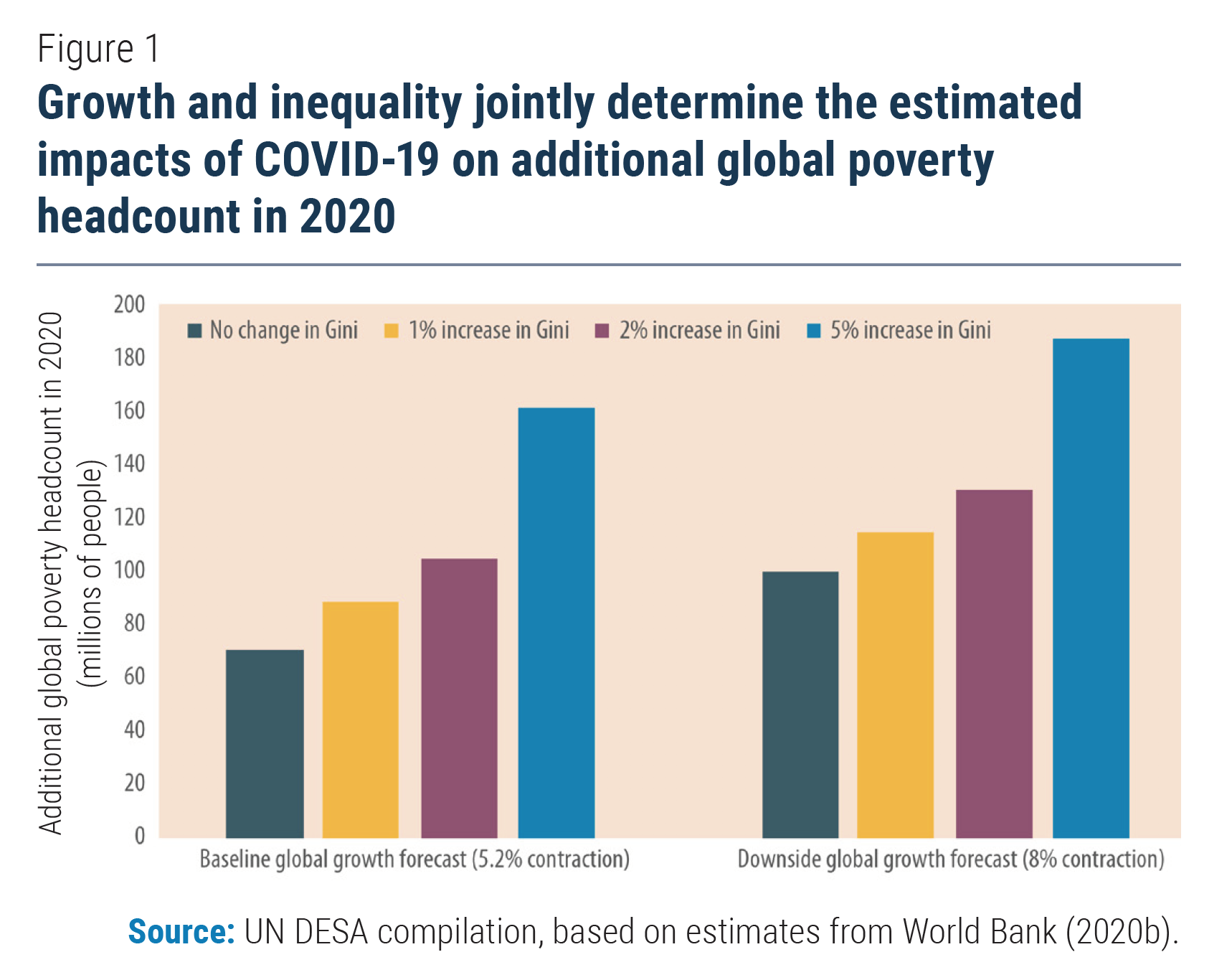 Beyond the immediate emergency actions, the longer-term economic policy responses in the recovery phase must be calibrated to help countries be better prepared for future waves of COVID-19 and other pandemics. The rapid speed at which a virus such as COVID-19 could spread calls for the introduction of automatic stabilizer-like income support measures that would kick in when the epidemiological situation crosses some pre-determined thresholds. Such measures may reduce the pressure on people to go out for work at the risk of contracting and spreading the virus, while preventing a sharp economic downturn by maintaining people’s purchasing power at a desired level. Longer-term fiscal interventions should direct government resources to support the development of facilities for large-scale testing, tracing and quarantining, and adequate stockpiling of personal protective equipment. Investment in monitoring systems that allow better tracking of the epidemiological situations at a higher resolution, e.g., districts within a city, should be pursued. This could enable targeted lockdowns that affect smaller populations, thereby lowering the economic and social damages caused by general mobility restrictions. In the face of a slow recovery for the global economy, a more equitable distribution of income will be necessary to ensure progress toward the SDGs concerning poverty, hunger, and other material deprivation. For example, figure 1 shows that the increase in global poverty headcount will be lower if there is less increase in inequality. Adoption of more assertive policies (including progressive taxation and expenditure policies) to address inequality can therefore help a country to move away from the pessimistic scenario and be ensconced in the optimistic scenario.
Beyond the immediate emergency actions, the longer-term economic policy responses in the recovery phase must be calibrated to help countries be better prepared for future waves of COVID-19 and other pandemics. The rapid speed at which a virus such as COVID-19 could spread calls for the introduction of automatic stabilizer-like income support measures that would kick in when the epidemiological situation crosses some pre-determined thresholds. Such measures may reduce the pressure on people to go out for work at the risk of contracting and spreading the virus, while preventing a sharp economic downturn by maintaining people’s purchasing power at a desired level. Longer-term fiscal interventions should direct government resources to support the development of facilities for large-scale testing, tracing and quarantining, and adequate stockpiling of personal protective equipment. Investment in monitoring systems that allow better tracking of the epidemiological situations at a higher resolution, e.g., districts within a city, should be pursued. This could enable targeted lockdowns that affect smaller populations, thereby lowering the economic and social damages caused by general mobility restrictions. In the face of a slow recovery for the global economy, a more equitable distribution of income will be necessary to ensure progress toward the SDGs concerning poverty, hunger, and other material deprivation. For example, figure 1 shows that the increase in global poverty headcount will be lower if there is less increase in inequality. Adoption of more assertive policies (including progressive taxation and expenditure policies) to address inequality can therefore help a country to move away from the pessimistic scenario and be ensconced in the optimistic scenario.
Strengthening healthcare and social protection
One of the important lessons of the COVID-19 experience is that even low-income countries cannot leave the establishment of robust universal healthcare and social protection systems as distant goals. Instead, they need to consider them as immediate goals and should build upon the emergency measures taken during the COVID-19 crisis to achieve them. In many developed countries, healthcare and social protection were first employment-driven and only later acquired a more universal character. This gradual progression may not be appropriate for many developing countries, where vast sections of the population are either self-employed or work in the informal sector. Transfer of the bulk of the population of these countries to employment in the formal sector will require a long time, and its success remains uncertain because of the new technologies that are changing the nature of work away from being formal and permanent. Under these circumstances, many developing countries may need to accomplish an institutional leapfrogging from very little to universal healthcare and social protection (which could include Universal Basic Income). Some examples show that appropriate policies and bold initiatives can allow committed developing countries to carry out such leapfrogging. The policies that may help countries get on the trajectory of the optimistic scenario regarding the health goals include: (i) increasing public spending on the health sector; (ii) emphasizing primary and preventive healthcare; (iii) ensuring hygienic housing and living conditions for all (instead of passively witnessing large numbers of rural migrants ending up in urban slums); (iv) shock-proofing the healthcare system against future epidemics and pandemics; and (v) making more use of technologies and telemedicine to ensure affordable healthcare for all, including those living in remote and inaccessible areas, which requires investment in digital infrastructures and access to technologies. Regarding social protection, a three-pronged strategy can enable a country to follow the COVID-19 optimistic scenario. This strategy includes: (i) accelerating efforts to achieve universal, nationally appropriate social protection floors; (ii) shock-proofing social protection systems; and (iii) adapting social protection systems to the new digital economy. Figure 2 shows how much better global outcomes regarding various dimensions of social protection can be achieved under the COVID-19 optimistic scenario as compared to that under either the pre-COVID-19 situation or COVID-19 pessimistic scenario.
Sustainable recovery and protecting the planet
One of the priorities of the post-COVID-19 period must be to maintain the downward trend in greenhouse gas (GHG) emissions, observed during the pandemic, and make it sustainable and robust, so that the Paris climate change targets are achieved. Figure 3 illustrates, based on industrial emissions, the possibility of the three scenarios. Under the pessimistic scenario, the emissions reduction observed during the COVID-19 crisis proves temporary, and the world gets back to the pre-COVID-19 trend. By contrast, under the optimistic scenario, the change in trend observed during the COVID-19 crisis is made durable. To realize the optimistic scenario, a significant part of the resources earmarked for COVID-19 recovery can be directed to investments needed to reduce GHG emissions. The current low fuel prices may be used to introduce carbon pricing instruments – including carbon tax and emissions trading scheme – and reduce fossil fuel subsidies to both discourage GHG emissions and provide more resources to finance various types of climate action. Given that many of the GHG mitigation activities are labour-intensive, investments in these activities will also help to generate employment. The concrete areas of investment for climate action include: (i) power generation using renewable energy sources; (ii) building smart grids; (iii) developing high capacity batteries; (iv) carbon capture and sequestration; (v) development of new clean fuels; (vi) production and use of power-saving appliances; and (vii) switching to electric vehicles based on clean power. Investments are also needed for adaptation purposes, particularly in developing low-lying countries that are hit hard by the effects of climate change. Depending on the maturity of these technologies, investments should serve different purposes. For a mature technology such as solar panel, investments should be geared toward promoting adoption of the technology. Whereas for carbon capture and sequestration that remains commercially unviable at a large scale, investments would need to be directed more towards research and development and supported by a commensurate innovation policy framework. Policies that may facilitate climate action include: (i) direct public investment; (ii) subsidized financing of private investment; (iii) providing a guaranteed market for clean power; (iv) ensuring necessary cooperation among firms operating in the energy sector; (v) enabling cooperation between the energy industry and the related R&D organizations; and (vi) mobilization of the public. Phased out over the short-, medium-, and long-run, these policies can help a country to avoid the COVID-19 pessimistic scenario and proceed along the optimistic scenario and reach the climate action goals. 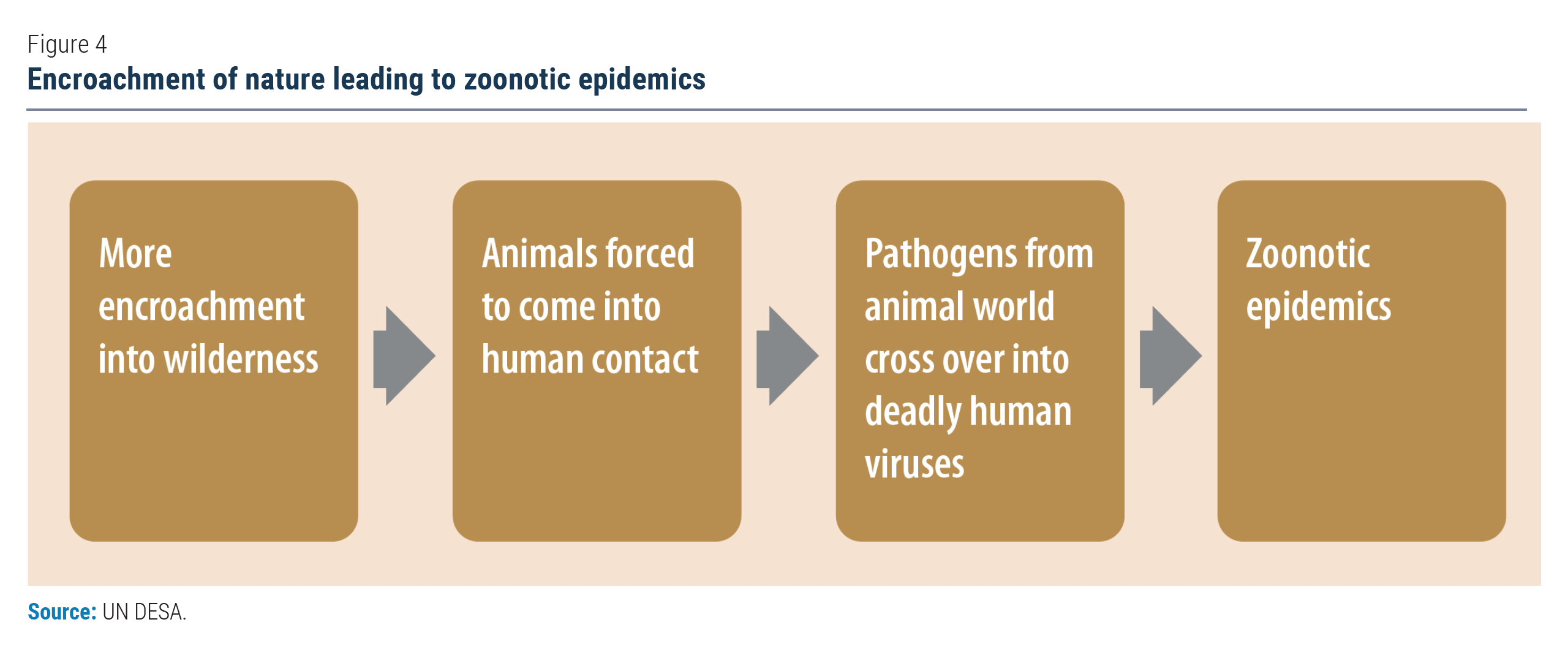 The zoonotic nature of COVID-19 and other recent epidemics (Figure 4) have yet again shown the urgency to reduce human pressure on nature and to protect land, water, and biodiversity. Some positive indications of relieving human pressure on nature that were observed during the COVID-19 crisis therefore need to be sustained and further expanded. This would require meeting the Aichi biodiversity targets of the Convention on Biological Diversity, including target 11, which requires countries to preserve 17 per cent of their terrestrial area and 10 per cent of marine areas as protected from human interventions. So far, these targets remain unmet by most countries, and particularly regarding the Key Biodiversity Areas (KBAs) (see Figure 5).
The zoonotic nature of COVID-19 and other recent epidemics (Figure 4) have yet again shown the urgency to reduce human pressure on nature and to protect land, water, and biodiversity. Some positive indications of relieving human pressure on nature that were observed during the COVID-19 crisis therefore need to be sustained and further expanded. This would require meeting the Aichi biodiversity targets of the Convention on Biological Diversity, including target 11, which requires countries to preserve 17 per cent of their terrestrial area and 10 per cent of marine areas as protected from human interventions. So far, these targets remain unmet by most countries, and particularly regarding the Key Biodiversity Areas (KBAs) (see Figure 5). 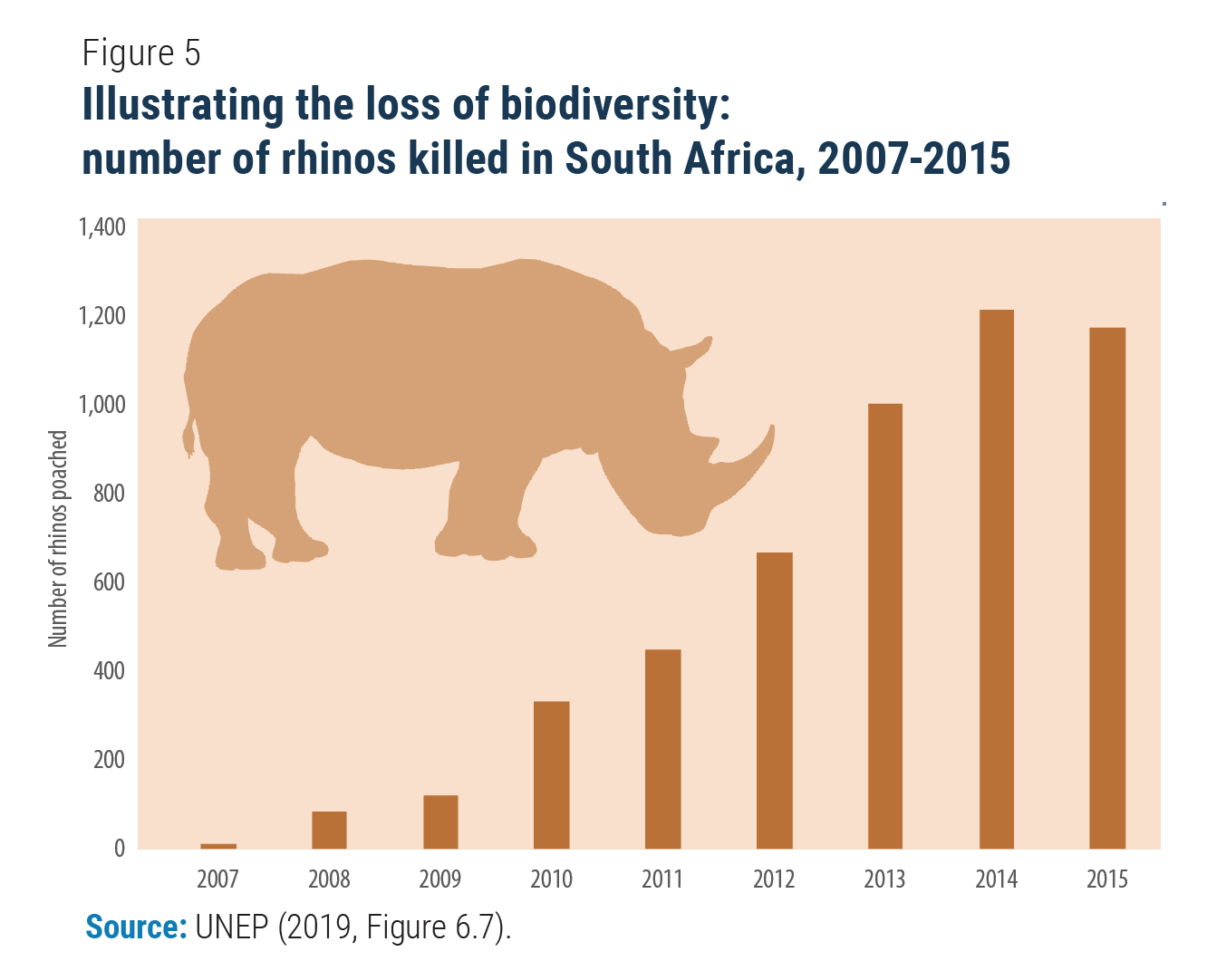 One reason for the relentless increase of human pressure on nature is growth in the global volume of material consumption and production. Sustaining the current volume requires almost twice the biocapacity that Earth can offer. In addition to the increase in volume, there has been a shift in the composition of waste, with a dramatic increase in non-biodegradable plastics. While vast sections of the populations in the developing world still need to increase their material consumption level, urgent measures are necessary to reduce the impact on nature by encouraging efforts to (i) reduce, reuse and recycle; (ii) adopt circular economies; (iii) shift consumption toward digital products; and (iv) fundamentally reconfigure social institutions, facilitating delinking of economic growth from an increase in material consumption.
One reason for the relentless increase of human pressure on nature is growth in the global volume of material consumption and production. Sustaining the current volume requires almost twice the biocapacity that Earth can offer. In addition to the increase in volume, there has been a shift in the composition of waste, with a dramatic increase in non-biodegradable plastics. While vast sections of the populations in the developing world still need to increase their material consumption level, urgent measures are necessary to reduce the impact on nature by encouraging efforts to (i) reduce, reuse and recycle; (ii) adopt circular economies; (iii) shift consumption toward digital products; and (iv) fundamentally reconfigure social institutions, facilitating delinking of economic growth from an increase in material consumption.
Better governance and stronger partnerships
Another important lesson of the COVID-19 crisis is that, with the investment in efficient governance systems, even countries at a relatively low-income level can effectively confront emergencies such as the one posed by the pandemic. National governance arrangements are extremely diverse, and the COVID-19 experience shows that there is no one governance model that is superior to all others. But analyses of the development since the beginning of the pandemic demonstrates the relevance of key dimensions of governance highlighted in SDG 16 to successfully limiting the spread of the pandemic and enabling recovery. In this view, countries need to pay special attention to improving their governance by ensuring: (i) effective communication and transparency; (ii) stakeholder engagement and participation; (iii) accountability and anti-corruption; (iv) effective coordination across units of governments (horizontal integration); (v) effective coordination across levels of governments; (vi) technical competency of the bureaucracy; and (vii) smart use of technology. The COVID-19 crisis has shown that the world has now become so integrated that the public health of one country easily affects the public health of other countries. For the world as a whole, the public healthcare system can therefore be only as strong as it is in the weakest country. Consequently, building a robust public healthcare system in countries lacking one is the responsibility not only of the respective country but also of the global community. Furthermore, dealing with the COVID-19 pandemic and its effects is the responsibility not only of national governments but also of other stakeholders. Going forward, greater partnership is necessary among countries and all stakeholders within and across countries for confronting future public health crises and for achieving the SDGs.
 Welcome to the United Nations
Welcome to the United Nations
